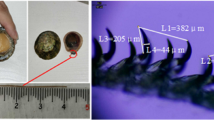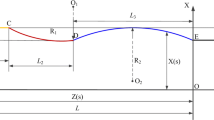Abstract
Bionic design of cutting tools to reduce working resistance and energy consumption has always been a concern of people. The curve of the rake face of beaver teeth is fitted, and its general expression is obtained. This curvilinear function is used in the configuration design of the bionic alignment of the rake face of cylindrical milling cutter, and the bionic curvilinear configuration rake face cylindrical milling cutter is designed. By constructing a three-dimensional milling simulation model of a cylindrical milling cutter, the cutting performance of a cylindrical milling cutter with a bionic collinear configuration and a cylindrical milling cutter was analyzed by comparing the milling simulation with flat front face in different combinations of front face collinear parameter values. The results show that the designed bionic collinear configuration front face cylindrical milling cutter exhibits certain force saving effect and is verified by right angle free cutting experiments, but its drag reduction performance is affected by the parameter values of the collinear. The optimized parameter values of the front face collinear of the tool with a certain side draft are obtained by genetic algorithm combined with finite element simulation analysis, and the optimal combination of collinear parameter values is obtained. The results of simulation analysis prove that the optimisation method is effective. Finally, this paper builds an experimental validation platform to transform milling machining with variable cutting thickness into turning machining with uniform thickness using an equivalent uniform cutting thickness model. The results of the simulation experiments are effectively verified by the right-angle free cutting experiments, and this study will open up new design ideas for the optimal design of the conformation of cylindrical milling cutters.














Similar content being viewed by others
Data availability
The datasets generated during and/or analyzed during the current study are available from the corresponding author on reasonable request.
References
Astakhov VP, Xiao X (2008) A methodology for practical cutting force evaluation based on the energy spent in the cutting system. Mach Sci Technol 12:325–347. https://doi.org/10.1080/10910340802306017
Guo J, Wang X, Zhao Y, Xu Y, Cui H, Wei Z, Jin Z, Kang R (2021) Recent progress on fabrication technologies and machining performance of textured cutting tools. Chinese J Mech Eng 57:172–200. https://doi.org/10.3901/JME.2021.13.172
Tong X, Yang S, He C, Zheng M (2019) Multi-objective optimization of cutting performance of variable density micro-texture ball-end milling tool. J Mech Eng 55:221–232. https://doi.org/10.3901/JME.2019.21.221
Ren L, Liang Y (2012) Coupled bionics. China Science Publishing, Beijing, pp 56–72
Liu C (2008) Studies on the mechanism of claw and toe cutting in the mole rat (Scaptochirus moschatus). Jilin University, Changcun
Shu LH, Ueda K, Chiu I, Cheong H (2011) Biologically inspired design. CIRP Ann 60:673–693. https://doi.org/10.1016/j.cirp.2011.06.001
Ren L-Q, Tong J, Li J-Q, Chen B-C (2001) SW—soil and water: soil adhesion and biomimetics of soil-engaging components: a review. J Agric Eng Res 79:239–263. https://doi.org/10.1006/jaer.2001.0722
Guo Z, Zhou Z, Ren L (2003) 2d finite element analysis for the cutting performance of bionic curved cutting tools. Chinese J Mech Eng 106-109. https://doi.org/10.3901/JME.2003.09.106
Guo Z, Zhou D, Zhou Z (2010) simulation research on mechanical performances of several kinds of cultivating components with different soil-engaging surfaces. Chinese J Mech Eng 46:71–75. https://doi.org/10.3901/jme.2010.15.071
Clara S, Habersetzer J, Witzel U (2016) Biomechanical aspects of incisor action of beavers (Castor fiber L.). J Mammal 97:619–630. https://doi.org/10.1093/jmammal/gyv209
Sun J, Chen H, Wang Z, Ou Z, Yang Z, Liu Z, Duan J (2020) Study on plowing performance of EDEM low-resistance animal bionic device based on red soil. Soil Tillage Res 196:104336. https://doi.org/10.1016/j.still.2019.104336
Tesliuk H, Volik BG, Sokol S, Ponomarenko N (2019) Design of working bodies for tillage tools using the methods of bionics. Eastern-Eur J Enter Technol. https://doi.org/10.15587/1729-4061.2019.169156
Jiang Z, Sun J, Xiong Q, Wang L, Li J (2017) Structural design of groove and micro-blade of the end mill in aluminum alloys machining based on bionics. Int J Adv Manuf Technol 88:3343–3356. https://doi.org/10.1007/s00170-016-9022-5
Shi H (2018) Metal cutting theory: new perspectives and new approaches. Springer, pp 101–126
Xiong L (2015) Improved Dijkstra’s algorithm for energy-saving optimisation of twist drill edge shape. Journal of Huazhong University of Science and Technology (Natural Science Edition) 43:1–6. https://doi.org/10.13245/j.hust.150101
Wu W, Xin Z (2009) Metal cutting principles and tools. National Defence Industry Press, Beijing, pp 241–242
Liu L, Wu M, Li L, Cheng Y (2020) FEM simulation and experiment of high-pressure cooling effect on cutting force and machined surface quality during turning Inconel 718. Integr Ferroelectr 206:160–172. https://doi.org/10.1080/10584587.2020.1728637
Li S, Su Q, Wang X, Wu Y, Zhao X, Chang Y (2022) Modification of the Johnson–Cook model for metal at a wide range of strain rates and application in the dynamic response of honeycomb panels. Model Simul Mater Sci Eng 30:085012. https://doi.org/10.1088/1361-651X/ac9d53
Xin C, Xue Z, Tu J (2019) Handbook of common material parameters for finite element analysis. Machinery Industry Press, Beijing, pp 114–115
Thakur N, Kumar P, Singh Bharj R (2018) Effect of variation of johnson-cook parameters on kinetic energy and simulation of 4340 steel projectile. Mater Today: Proc 5:27884–27892. https://doi.org/10.1016/j.matpr.2018.10.027
Wang F, Tao Q, Xu L (2019) Development of metal cutting simulation platform based on Python language. J Jilin Univ (Engineering and Technology Edition) 49:492–498. https://doi.org/10.13229/j.cnki.jdxbgxb20171214
Sun Y (2014) Parametric modelling of titanium alloy milling process and prediction of tool wear state. Shandong University
Ruan J, Gong A, Zhou X (2009) Finite element simulation of high-speed cutting material MTMoCr. China Mech Eng 20:1372–1375. https://doi.org/10.3321/j.issn:1004-132X.2009.11.026
Funding
The authors received financial support from the National Nature Science Foundation (No. 51975003)
Author information
Authors and Affiliations
Contributions
Chao Lei wrote the whole manuscript and carried out simulations and experiments, Feng Xie was in charge of the whole research and modified the manuscript, Fangchao Wu modified the manuscript, and Qiang Yan modified the manuscript and assisted with the experiments.
Corresponding author
Ethics declarations
Ethical approval
Not applicable.
Consent to participate
Not applicable.
Consent to publication
Not applicable.
Conflict of interest
The authors declare no competing interests.
Additional information
Publisher’s Note
Springer Nature remains neutral with regard to jurisdictional claims in published maps and institutional affiliations.
Rights and permissions
Springer Nature or its licensor (e.g. a society or other partner) holds exclusive rights to this article under a publishing agreement with the author(s) or other rightsholder(s); author self-archiving of the accepted manuscript version of this article is solely governed by the terms of such publishing agreement and applicable law.
About this article
Cite this article
Lei, C., Xie, F., Wu, F. et al. Research on bionic design of cylindrical milling cutter based on the curvilinear configuration of the rake face of beaver teeth. Int J Adv Manuf Technol 130, 4905–4917 (2024). https://doi.org/10.1007/s00170-024-12951-y
Received:
Accepted:
Published:
Issue Date:
DOI: https://doi.org/10.1007/s00170-024-12951-y




